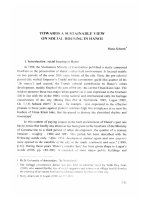Theoretical Perspectives on Social Stratification
Bạn đang xem bản rút gọn của tài liệu. Xem và tải ngay bản đầy đủ của tài liệu tại đây (1.59 MB, 6 trang )
Theoretical Perspectives on Social Stratification
Theoretical Perspectives on
Social Stratification
Bởi:
OpenStaxCollege
Basketball is one of the highest-paying professional sports. There is stratification even
among teams. For example, the Minnesota Timberwolves hand out the lowest annual
payroll, while the Los Angeles Lakers reportedly pay the highest. Kobe Bryant, a Lakers
shooting guard, is one of the highest paid athletes in the NBA, earning around $25
million a year (Basketballreference.com 2011). Even within specific fields, layers are
stratified and members are ranked.
In sociology, even an issue such as NBA salaries can be seen from various points
of view. Functionalists will examine the purpose of such high salaries, while conflict
theorists will study the exorbitant salaries as an unfair distribution of money. Social
stratification takes on new meanings when it is examined from different sociological
perspectives—functionalism, conflict theory, and symbolic interactionism.
Functionalism
In sociology, the functionalist perspective examines how society’s parts operate.
According to functionalism, different aspects of society exist because they serve a
needed purpose. What is the function of social stratification?
In 1945, sociologists Kingsley Davis and Wilbert Moore published the Davis-Moore
thesis, which argued that the greater the functional importance of a social role, the
greater must be the reward. The theory posits that social stratification represents the
inherently unequal value of different work. Certain tasks in society are more valuable
than others. Qualified people who fill those positions must be rewarded more than
others.
According to Davis and Moore, a firefighter’s job is more important than, for instance, a
grocery store cashier’s. The cashier position does not require the same skill and training
level as firefighting. Without the incentive of higher pay and better benefits, why would
someone be willing to rush into burning buildings? If pay levels were the same, the
firefighter might as well work as a grocery store cashier. Davis and Moore believed
1/6
Theoretical Perspectives on Social Stratification
that rewarding more important work with higher levels of income, prestige, and power
encourages people to work harder and longer.
Davis and Moore stated that, in most cases, the degree of skill required for a job
determines that job’s importance. They also stated that the more skill required for a job,
the fewer qualified people there would be to do that job. Certain jobs, such as cleaning
hallways or answering phones, do not require much skill. The employees don’t need
a college degree. Other work, like designing a highway system or delivering a baby,
requires immense skill.
In 1953, Melvin Tumin countered the Davis-Moore thesis in “Some Principles of
Stratification: A Critical Analysis.” Tumin questioned what determined a job’s degree
of importance. The Davis-Moore thesis does not explain, he argued, why a media
personality with little education, skill, or talent becomes famous and rich on a reality
show or a campaign trail. The thesis also does not explain inequalities in the education
system, or inequalities due to race or gender. Tumin believed social stratification
prevented qualified people from attempting to fill roles (Tumin 1953). For example, an
underprivileged youth has less chance of becoming a scientist, no matter how smart she
is, because of the relative lack of opportunity available to her.
The Davis-Moore thesis, though open for debate, was an early attempt to explain why
stratification exists. The thesis states that social stratification is necessary to promote
excellence, productivity, and efficiency, thus giving people something to strive for.
Davis and Moore believed that the system serves society as a whole because it allows
everyone to benefit to a certain extent.
Conflict Theory
These people are protesting a decision made by Tennessee Technological University in
Cookeville, Tennessee, to lay off custodians and outsource the jobs to a private firm to avoid
paying employee benefits. Private job agencies often pay lower hourly wages. Is it fair? (Photo
courtesy of Brian Stansberry/Wikimedia Commons)
2/6
Theoretical Perspectives on Social Stratification
Conflict theorists are deeply critical of social stratification, asserting that it benefits only
some people, not all of society. For instance, to a conflict theorist, it seems wrong that
a basketball player is paid millions for an annual contract while a public school teacher
earns $35,000 a year. Stratification, conflict theorists believe, perpetuates inequality.
Conflict theorists try to bring awareness to inequalities, such as how a rich society can
have so many poor members.
Many conflict theorists draw on the work of Karl Marx. During the 19th-century era of
industrialization, Marx believed social stratification resulted from people’s relationship
to production. People were divided by a single line: they either owned factories or
worked in them. In Marx’s time, bourgeois capitalists owned high-producing
businesses, factories, and land, as they still do today. Proletariats were the workers who
performed the manual labor to produce goods. Upper-class capitalists raked in profits
and got rich, while working-class proletariats earned skimpy wages and struggled to
survive. With such opposing interests, the two groups were divided by differences of
wealth and power. Marx saw workers experience deep alienation, isolation and misery
resulting from powerless status levels (Marx 1848).
Today, while working conditions have improved, conflict theorists believe that the
strained working relationship between employers and employees still exists. Capitalists
own the means of production, and a system is in place to make business owners rich and
keep workers poor. According to conflict theorists, the resulting stratification creates
class conflict.
Symbolic Interactionism
Symbolic interactionism is a theory that uses everyday interactions of individuals to
explain society as a whole. Symbolic interactionism examines stratification from a
micro-level perspective. This analysis strives to explain how people’s social standing
affects their everyday interactions.
In most communities, people interact primarily with others who share the same social
standing. It is precisely because of social stratification that people tend to live, work,
and associate with others like themselves, people who share their same income level,
educational background, or racial background, and even tastes in food, music, and
clothing. The built-in system of social stratification groups people together.
Symbolic interactionists also note that people’s appearance reflects their perceived
social standing. Housing, clothing, and transportation indicate social status, as do
hairstyles, taste in accessories, and personal style.
3/6
Theoretical Perspectives on Social Stratification
(a) A group of construction workers on the job site, and (b) a group of businessmen.
What categories of stratification do these construction workers share? How do
construction workers differ from executives or custodians? Who is more skilled? Who
has greater prestige in society? (Photo (a) courtesy of Wikimedia Commons; Photo (b)
courtesy of Chun Kit/flickr)
Conspicuous consumption refers to buying certain products to make a social statement
about status. Carrying pricey but eco-friendly water bottles could indicate a person’s
social standing. Some people buy expensive trendy sneakers even though they will never
wear them to jog or play sports. A $17,000 car provides transportation as easily as a
$100,000 vehicle, but the luxury car makes a social statement that the less expensive car
can’t live up to. All of these symbols of stratification are worthy of examination by an
interactionist.
Summary
Social
stratification
can
be
examined
from
different
sociological
perspectives—functionalism, conflict theory, and symbolic interactionism. The
functionalist perspective states that systems exist in society for good reasons. Conflict
theorists observe that stratification promotes inequality, such as between rich business
owners and poor workers. Symbolic interactionists examine stratification from a micro4/6
Theoretical Perspectives on Social Stratification
level perspective. They observe how social standing affects people’s everyday
interactions and how the concept of “social class” is constructed and maintained through
everyday interactions.
Section Quiz
The basic premise of the Davis-Moore thesis is that the unequal distribution of rewards
in social stratification:
1. is an outdated mode of societal organization
2. is an artificial reflection of society
3. serves a purpose in society
4. cannot be justified
Answer
C
Unlike Davis and Moore, Melvin Tumin believed that, because of social stratification,
some qualified people were _______ higher-level job positions.
1. denied the opportunity to obtain
2. encouraged to train for
3. often fired from
4. forced into
Answer
A
Which statement represents stratification from the perspective of symbolic
interactionism?
1. Men often earn more than women, even working the same job.
2. After work, Pat, a janitor, feels more comfortable eating in a truck stop than a
French restaurant.
3. Doctors earn more money because their job is more highly valued.
4. Teachers continue to struggle to keep benefits such as health insurance.
Answer
B
When Karl Marx said workers experience alienation, he meant that workers:
1. must labor alone, without companionship
2. do not feel connected to their work
5/6
Theoretical Perspectives on Social Stratification
3. move from one geographical location to another
4. have to put forth self-effort to get ahead
Answer
B
Conflict theorists view capitalists as those who:
1. are ambitious
2. fund social services
3. spend money wisely
4. get rich while workers stay poor
Answer
D
Short Answer
Analyze the Davis-Moore thesis. Do you agree with Davis and Moore? Does social
stratification play an important function in society? What examples can you think of that
support the thesis? What examples can you think of that refute the thesis?
Consider social stratification from the symbolic interactionist perspective. How does
social stratification influence the daily interactions of individuals? How do systems of
class, based on factors such as prestige, power, income, and wealth, influence your own
daily routines, as well as your beliefs and attitudes? Illustrate your ideas with specific
examples and anecdotes from your own life and the lives of people in your community.
References
Basketball-reference.com. 2011 “2010–11 Los Angeles Lakers Roster and Statistics.”
Retrieved January 9, 2012 ( />2011.html).
Davis, Kingsley and Wilbert E. Moore. “Some Principles of Stratification.” American
Sociological Review 10(2):242–249. Retrieved January 9, 2012 ( />stable/2085643).
Marx, Karl. 1848. Manifesto of the Communist Party. Retrieved January 9, 2012
( />Tumin, Melvin M. 1953. “Some Principles of Stratification: A Critical Analysis.”
American Sociological Review 18(4):387–394.
6/6









